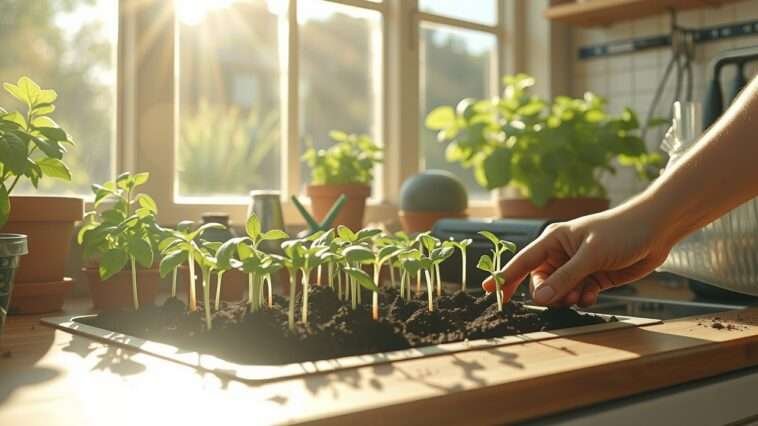If you’re looking to grow your own food, focusing on plants that are easy to cultivate and commonly used in daily meals is a smart choice. Here’s a ranked list of the best foods to grow yourself, starting with the easiest and most versatile:
1. Herbs (Basil, Mint, Cilantro, Parsley)
- Why: Incredibly easy to grow and widely used in cooking.
- Uses: Flavoring for soups, sauces, teas, and garnishes.
- Growing Tips:
- Requires small pots (6-8 inches deep) and partial to full sunlight.
- Trim leaves frequently to encourage new growth.
2. Lettuce
- Why: Quick-growing, versatile, and great for salads, sandwiches, and wraps.
- Uses: Salad greens and garnish.
- Growing Tips:
- Ideal for shallow containers (6-8 inches).
- Thrives in partial shade with regular watering.
3. Spinach
- Why: Fast-growing, nutrient-dense, and can be used in various dishes.
- Uses: Salads, smoothies, sautés, and soups.
- Growing Tips:
- Prefers cool weather and moist soil.
- Harvest outer leaves regularly.
4. Tomatoes
- Why: Easy to grow and essential for sauces, salads, and cooking.
- Uses: Salads, sauces, soups, and condiments.
- Growing Tips:
- Use large pots (18-20 inches deep) with support stakes.
- Full sunlight and consistent watering are key.
5. Green Onions (Scallions)
- Why: Super easy to grow and regrow from scraps.
- Uses: Garnishes, stir-fries, soups, and salads.
- Growing Tips:
- Plant in shallow soil or a water jar to regrow continuously.
- Requires partial to full sun.
6. Radishes
- Why: One of the fastest-growing vegetables (ready in 3-4 weeks).
- Uses: Salads, pickles, and garnishes.
- Growing Tips:
- Requires loose, sandy soil and a small pot (6-8 inches deep).
- Harvest when roots are firm and about an inch in diameter.
7. Peppers (Bell Peppers, Chili Peppers)
- Why: Productive plants that add flavor and spice to meals.
- Uses: Salads, stir-fries, and sauces.
- Growing Tips:
- Use medium pots (12 inches deep) and ensure full sunlight.
- Water deeply but allow soil to dry between watering.
8. Potatoes
- Why: High-yielding and versatile in cooking.
- Uses: Mashed, roasted, fried, and soups.
- Growing Tips:
- Grow in deep containers or bags (18-20 inches).
- Add soil as plants grow to encourage tuber production.
9. Carrots
- Why: Easy to grow in loose soil and a staple in many dishes.
- Uses: Soups, salads, and snacks.
- Growing Tips:
- Use deep pots (12 inches) for long varieties.
- Keep soil moist for uniform root development.
10. Zucchini
- Why: High-yielding and versatile in cooking.
- Uses: Stir-fries, breads, and casseroles.
- Growing Tips:
- Use large pots (24 inches deep and wide).
- Provide plenty of sunlight and space for vines to spread.
11. Cucumbers
- Why: Fast-growing and perfect for salads and pickling.
- Uses: Salads, snacks, and pickles.
- Growing Tips:
- Use medium pots (12-18 inches deep) with a trellis for climbing.
- Water consistently for juicy cucumbers.
12. Peas
- Why: Easy to grow in cool weather and highly productive.
- Uses: Stir-fries, soups, and side dishes.
- Growing Tips:
- Use medium pots (12 inches deep) with a trellis.
- Harvest pods regularly to encourage more growth.
13. Beans (Green Beans, Bush Beans)
- Why: High-yielding and versatile.
- Uses: Soups, stir-fries, and side dishes.
- Growing Tips:
- Use medium pots (12 inches deep).
- Pole varieties need vertical support.
14. Garlic
- Why: Simple to grow from cloves and essential in cooking.
- Uses: Seasoning for nearly all savory dishes.
- Growing Tips:
- Plant cloves in well-drained soil in medium pots (12 inches deep).
- Takes several months but stores well after harvest.
15. Herbs for Tea (Lemongrass, Chamomile, Mint)
- Why: Easy to grow and useful for beverages.
- Uses: Herbal teas, flavoring for drinks.
- Growing Tips:
- Grow in small pots (6-8 inches).
- Water regularly and trim leaves to encourage growth.
Tips for Growing Your Own Food:
- Sunlight: Most vegetables need 6-8 hours of sunlight daily.
- Soil: Use nutrient-rich, well-draining soil or compost.
- Watering: Water consistently but avoid overwatering.
- Fertilizer: Use organic fertilizers or compost for better yields.
- Space: Provide adequate space for roots and air circulation.
Where and how to grow the food:
Growing food indoors is a practical and rewarding option, especially if you have limited outdoor space. Here’s how to set up an indoor garden effectively, including tips for space optimization, lighting, and plant care.
Step 1: Choose the Right Location
- Light Availability:
- Select a location with plenty of natural light, such as near a south-facing window.
- For areas with limited sunlight, invest in grow lights (LED or fluorescent) to provide sufficient light.
- Space:
- Use shelves, windowsills, or hanging planters to maximize vertical space.
- Compact spaces like kitchen counters or walls can accommodate small herb gardens.
Step 2: Pick the Right Plants
Easy-to-Grow Indoor Options:
- Herbs: Basil, mint, cilantro, parsley, thyme, chives.
- Leafy Greens: Lettuce, spinach, kale, arugula.
- Root Vegetables: Radishes, carrots, green onions.
- Vining Plants (with support): Cherry tomatoes, peas, beans.
- Microgreens: Fast-growing and nutrient-dense options like mustard greens, alfalfa, and broccoli sprouts.
Step 3: Set Up the Growing Environment
1. Containers:
- Use pots with drainage holes to prevent waterlogging.
- Repurpose household items like jars, cans, or plastic bottles with added drainage.
- For deeper-rooted plants (e.g., carrots, tomatoes), use containers at least 12-18 inches deep.
2. Soil:
- Use a high-quality potting mix, which is lighter and retains moisture better than garden soil.
- Add compost or organic fertilizer for extra nutrients.
3. Watering:
- Keep the soil consistently moist but not soggy.
- Use a spray bottle for small plants to avoid overwatering.
- Place trays under pots to catch excess water.
4. Light:
- Natural Light: Place plants near a sunny window.
- Grow Lights: Position 6-12 inches above plants. Run lights for 12-16 hours per day for vegetables and 6-8 hours for herbs.
- Rotate plants weekly to ensure even light exposure.
5. Temperature and Humidity:
- Maintain a temperature of 65-75°F (18-24°C) for most plants.
- Use a humidifier if your home is dry, or place a tray of water near plants to increase humidity.
Step 4: Maintain and Monitor
- Pruning:
- Trim herbs and greens regularly to encourage growth.
- Remove dead or yellowing leaves to prevent pests.
- Pest Control:
- Check leaves for pests like aphids or mites.
- Use natural remedies like neem oil or insecticidal soap if needed.
- Fertilizing:
- Feed plants every 2-4 weeks with a water-soluble organic fertilizer.
- Pollination (if needed):
- For fruiting plants like tomatoes, gently shake flowers or use a small brush to mimic natural pollination.
Step 5: Use Vertical and Compact Gardening Techniques
- Vertical Gardens:
- Use wall-mounted planters, hanging pots, or tiered shelves.
- Install grow lights on shelves for multi-level planting.
- Hydroponics or Aquaponics:
- Invest in a hydroponic system for soil-free indoor gardening.
- Great for leafy greens, herbs, and some small fruiting plants.
- Window Boxes or Ledges:
- Ideal for herbs and small greens.
- Secure pots or boxes to prevent tipping.
Step 6: Specific Plant Care
- Herbs:
- Water when the top inch of soil feels dry.
- Harvest regularly to keep them producing.
- Leafy Greens:
- Plant seeds densely for baby greens; thin out for mature leaves.
- Tomatoes and Peppers:
- Use stakes or cages for support.
- Ensure 12+ hours of light and consistent watering.
- Carrots and Radishes:
- Use deep containers with loose soil.
- Water lightly but regularly to prevent cracking.
Benefits of Indoor Gardening
- Fresh, organic produce year-round.
- Saves money on grocery bills.
- Improves air quality and decorates your home.
- A fulfilling, low-maintenance hobby.





